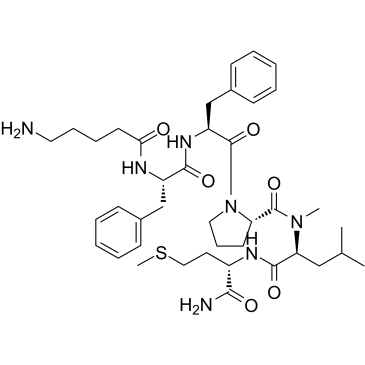GR 73632

GR 73632 structure
|
Common Name | GR 73632 | ||
|---|---|---|---|---|
| CAS Number | 133156-06-6 | Molecular Weight | 766.00500 | |
| Density | 1.198g/cm3 | Boiling Point | 1082.2ºC at 760mmHg | |
| Molecular Formula | C40H59N7O6S | Melting Point | N/A | |
| MSDS | USA | Flash Point | 608.3ºC | |
|
Neurokinin receptor modulation of respiratory activity in the rabbit.
Eur. J. Neurosci. 27(12) , 3233-43, (2008) The respiratory role of neurokinin (NK) receptors was investigated in alpha-chloralose-urethane-anaesthetized, vagotomized, paralysed and artificially ventilated rabbits by using bilateral microinjections (30-50 nL) of NK receptor agonists and antagonists. Mi... |
|
|
Phosphorylation of TRPV1 by neurokinin-1 receptor agonist exaggerates the capsaicin-mediated substance P release from cultured rat dorsal root ganglion neurons.
Neuropharmacology 55(8) , 1405-11, (2008) The present study was conducted to determine whether the activation of neurokinin-1 receptor (NK-1R) by its agonist (GR73632) enhances the capsaicin-evoked substance P (SP) release using a radioimmunoassay. A pre-exposure to GR73632 enhanced the capsaicin-evo... |
|
|
Calcitonin gene-related peptide and substance P regulate the intestinal radiation response.
Clin. Cancer Res. 12(13) , 4112-8, (2006) Intestinal toxicity is important in the therapeutic use of radiation as well as in nontherapeutic radiation exposure scenarios. Enteric sensory nerves are critical for mucosal homeostasis and for an appropriate response to injury. This study assessed the role... |
|
|
Pharmacological characterization of T-2328, 2-fluoro-4'-methoxy-3'-[[[(2S,3S)-2-phenyl-3-piperidinyl]amino]methyl]-[1,1'-biphenyl]-4-carbonitrile dihydrochloride, as a brain-penetrating antagonist of tachykinin NK1 receptor.
J. Pharmacol. Sci. 106(1) , 121-7, (2008) The pharmacological properties of T-2328 were evaluated as an antagonist of the tachykinin neurokinin 1 (NK(1)) receptor. T-2328 inhibited the specific binding of [(3)H][Sar(9),Met(O(2))(11)]substance P to tachykinin NK(1) receptors in human lymphoblastic IM9... |
|
|
Ava[L-Pro9,N-MeLeu10] substance P(7-11) (GR 73632) and Sar9, Met(O2)11 increase distention-induced peristalsis through activation of neurokinin-1 receptors on smooth muscle and interstitial cells of cajal.
J. Pharmacol. Exp. Ther. 317(1) , 439-45, (2006) Substance P is generally considered an excitatory neurotransmitter related to gut motor activity, although an inhibitory influence of neurokinin-1 (NK1) receptor activation on peristalsis has also been reported. With an optimized in vitro method to assess dis... |
|
|
Ablation of least shrew central neurokinin NK1 receptors reduces GR73632-induced vomiting.
Behav. Neurosci. 123(3) , 701-6, (2009) The neurocircuitry mediating the emetic reflex is still incompletely understood, and a key question is the degree to which central and/or peripheral components contribute to the overall vomiting mechanism. Having previously found a significant peripheral comp... |
|
|
Identification of single-nucleotide polymorphisms of the human neurokinin 1 receptor gene and pharmacological characterization of a Y192H variant.
Pharmacogenomics J. 4(6) , 394-402, (2004) Neurokinin receptors in the central nervous system are involved in the neural circuitry of anxiety, depression and emesis. This has led to the development of nonpeptidic NK1 receptor antagonists as therapeutic agents. Clinical trials have shown that NK1 recep... |
|
|
Regulated norepinephrine transporter interaction with the neurokinin-1 receptor establishes transporter subcellular localization.
J. Biol. Chem. 288(40) , 28599-610, (2013) Neurokinin-1 receptor (NK1R) mediates down-regulation of human norepinephrine (NE) transporter (hNET) via protein kinase C (PKC). However, native NET regulation by NK1R and the mechanism by which NK1R targets NET among other potential effectors are unknown. E... |
|
|
Utilization of the least shrew as a rapid and selective screening model for the antiemetic potential and brain penetration of substance P and NK1 receptor antagonists.
Brain Res. 1214 , 58-72, (2008) Substance P (SP) is thought to play a cardinal role in emesis via the activation of central tachykinin NK1 receptors during the delayed phase of vomiting produced by chemotherapeutics. Although the existing supportive evidence is significant, due to lack of a... |
|
|
Increased ganglionic responses to substance P in hypertensive rats due to upregulation of NK(1) receptors.
Am. J. Physiol. Regul. Integr. Comp. Physiol. 279(5) , R1685-94, (2000) Intravenous injection of substance P (SP) increases renal nerve firing and heart rate in spontaneously hypertensive rats (SHRs) and Wistar-Kyoto rats (WKYs) by stimulating sympathetic ganglia. Blood pressure is increased in SHRs but lowered in WKYs. This stud... |